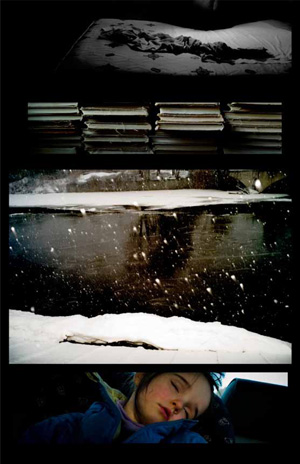
| |
| "It is with some joy that we meet works that can arouse amazement through the research of beauty and form. That's what happens to feel when discovering Tom Young's latest book. Try to travel inside this gorgeous book, one of the most beautiful of the last years, together with the music of the composer Max Richter. I listened to one of his records in particular, Blue Notebook, while vibrating Young's compositions through my eyes. Timeline is not only a superb photo story where memory, light and life mix, but a work signed by the presence of a renaissance. When he was a child, the author wasn't able to use his eyes for weeks because of a medical practice, a sensorial experience that changed his way to perceive himself in the world. The work becomes the answer to a series of questions that did not leave the author, from that moment onwards. Being only apparently a progressive story, Timeline is a circular story where each photo represents a space-time limit composed by several images and where, internally, the centrality of a wider image reflects in the satellite or in the following ones. We watch the story, between absence and presence of colour, not only of the story teller's privacy and of who tells his own intimacy, but, page after page, we watch the creation of a small world which we take part of. We should take care of time traveling more and more inside its pages, we could do it choosing different starting points, the book has a lot of entrances. At the beginning it will be the beauty of the compositions to attract us, then the discovery of the warp of the stories that multiply and in the end we will understand that Young's compositions have another type of strength that dwells in their fragility. The images in fact seem to arise around the consciousness of surrendering to time, that they witness just in evading, a certainly impossible action, the illusion that photography always takes with it, that is to tell truths stealing moments to time and therefore to the final dissolution. This one, as the photos of the book seem to reveal wisely, exists after all "only to eliminate the complacency of the possess that humiliates things"." —Augusto Petruzzi, Dome Magazine |
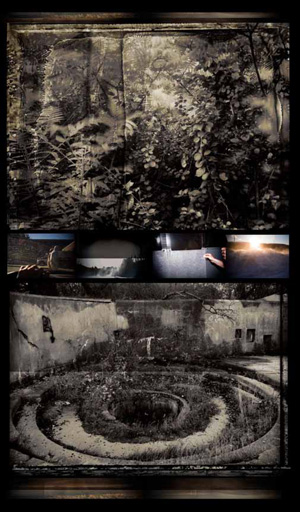 |
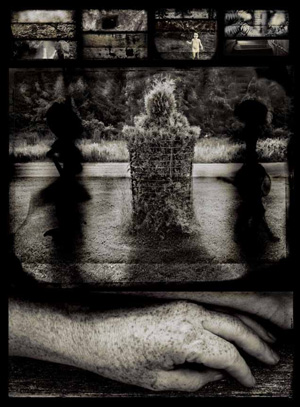 |
"At age ten, Tom Young had a medical procedure that left both his eyes fully bandaged for some weeks. During that time he explored his other newly heightened senses, and when it was time for his bandages to come off, he was struck by the power of light. Timeline: Learning to See with My Eyes Closed is a collection of photographic assemblages and collages that capture the power of light as it relates to memory. Memories, dreams, and imaginings all come together in Young's images to form a timeline in which everything merges and yet still has order, much like the way memory functions in reality. These photographs document Young's life — his wife's pregnancy, family members' serious illnesses — and yet are universal, allowing viewers to share the memories and images personally. Young's images are mysterious and evocative, requiring the viewer to look deeply at each photograph in order to understand and fully experience all that is portrayed. "This is a fascinating photography book like no other. You could spend days, weeks, years pouring over each image and trying to understand whether it represents pleasure or pain or a combination of years. Tom Young damaged his eyes at age ten and spent some weeks with them bandaged and unable to see. With this experience he learned to use his other senses more fully and could imagine various images. He has translated this experience to these most unusual images, which appear to be some sort of digital collage of totally unrelated pictures that somehow in the recesses of your mind come together in some supernatural comprehension. They are mystical, and you sense them as much as you see them, each provoking a strong feeling deep within the viewer, making you wonder what the photographer experienced and how much he is trying to convey or hide. It is a very unique and mystifying photo book you'll want to own so you can spend hours studying it and solving the mystery while being moved by the unusual images." |
"Timeline: Learning to See with My Eyes Closed is a sensual exploration of the act of seeing and how we grapple with the world around us in the face of adversity. The photographs are carefully collaged to reveal a loose narrative about the photographer's life and early memories of a surgical procedure that left his eyes bandaged for several weeks when he was a small child. The photographs in Timeline are sensual and visceral. As a viewer, it is easy to transport yourself to the site of each photograph—one can feel the weight of a small child in your hands. Reach out and run your fingers along a patch of foxtails, smell the musky, damp earth, and feel the warmth of light drawn in through the windows. Young illustrates the power of the photographic image; memory is tangible." "Tom Young's Timeline is the summation of a lifetime of conscious seeing by a master artist. Both highly personal and generously universal, Young's dream-like photographs probe the fault lines between memory and experience―a potent and creative fusion of past, present, and future that allows us to contemplate our own lives." "Tom Young's photo-collages in Timeline are poetic, beautiful, and complex evocations of memory, family history, the body, and life's mysteries. His layering of visual elements into a non-linear narrative leaves us with questions not only about the artist's life, but our own existence. Pondering both the questions and their possible answers is what makes Young's work so wonderful and enjoyable to experience." "Tom Young's delicate and enigmatic assemblages are rife with recollections of a time past. Like webs of synapses firing through tightly held mental pictures, his images trace the temporal slipperiness of memory. The film-like compositions fuse intimate glimpses of a family's life with scenes from unfamiliar spaces and places often ravaged by time. In Timeline, Young presents a beautifully singed portrait of the fragmentation of memory that speaks to the intensely human desire to reconstruct personal narrative through shards of remembered and misremembered moments." |
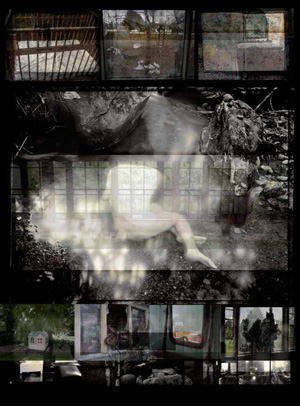 |
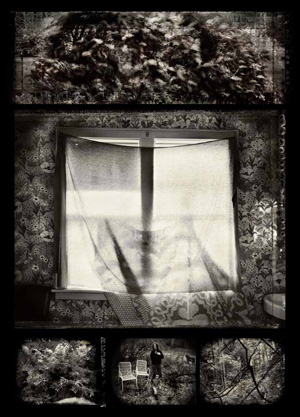 |
"In Tom Young's superbly designed and printed new book, Timeline: Learning to See with My Eyes Closed, he presents a series of images that incorporate the fundamental elements of both photography and design. Color. Scale. Balance. Proportion. In the 60 images included in the book, Tom combines his objective and nonobjective photographs into a single, harmonious composition, displaying his refined mastery of the visual language. "That said, Tom's images are not just examples of striking design; they are visual tone poems that possess an abundance of emotion. To me, this emotion is markedly dark and pensive. Many of the images (even though they were shot in color) give the immediate impression of being rendered in black and white. The greens and blues are minimal, often hidden in large areas of black and grey. The palette is dark, but the images have an intense, otherworldly beauty. "The images are mostly vertical in format and give the viewer a sense of gazing out (or in) a window. His framing of the photographs with solid black heightens this impression. Tom plays conspicuously with the scale of the photos. Some photos command a large portion of the overall image, while some are hardly noticeable at all. In each of Tom's pieces, the photos are expertly composed to create an elegant balance of image, design, and introspection." ―Jim Fitts, Fitts & Wolinsky |
"Tom Young is a retired career art teacher at Greenfield Community College (MA). He is also a photographer of radical vision who continues to teach in four-year art schools and whose work is represented in more than thirty permanent collections, including the Bibliotheque Nationale in Paris, the Museum of Fine Arts (Boston), and the Eastman Museum of Photography. This book of his work (oversize: 9" x 12") is produced by George F. Thompson Publishing. Young's medium is photocollage. Each is a single, subdivided image whose geometric format resembles a strip of film (the artist describes his childhood inspiration as a TV which had lost its vertical hold). Within the larger image, inset images involve staged objects, snapshots, interiors, landscapes, or manipulated photographs, all in black-and-white with understated, skillful color. The overall effect is haunting; domestic, revealing, and almost narrative, in ways reminiscent but not derivative of the work of Joseph Cornell. The artist calls the genre 'visual fiction.' The book's design, by David Skolkin, keeps things rooted in a spare, ordinary space. The images juxtapose faces, bare branches, worn-out cloth, empty interiors, and other intimations of mortality, but Young's small, deft evocations of casual moments in the everyday lives of people we might meet in the grocery store keep the work sad, lovely, and mysterious without falling into gothic extremity. The images carry great emotional weight. The book will be interesting to artists in many media and to anyone who has been fascinated by that old box filled with photographs, faded letters, a medal for heroism in a forgotten war, and a mysterious scrap of cloth." "The sophistication of his photography and the personal nature of his work combine to great effect. When you spend some time with Young's book, the takeaway is a feeling of unhinging from time, a simultaneous awareness of past and present, like nostalgia and mindfulness all at once. It's not clear exactly where that comes from, but, at least for Young, the source seems plain. "Once you've had a life-threatening illness, it's with you," he says. "It's in how you see everything, the world, even the clouds." |
|
